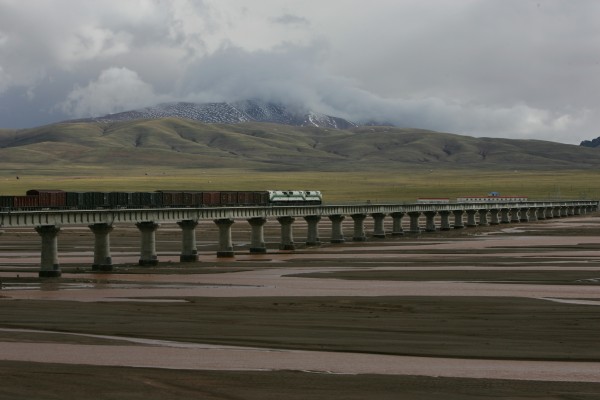Inroads: Tibet's Second Railway Line Opens
| David Perry | | Aug 15, 2014 01:55 PM EDT |
(Photo : Reuters) The Qinghai-Tibet Railway opens up one of the most inaccessible regions in China.
Linking regional capital Lhasa to the eastern city of Xigaze, the second stretch of Tibet's much-lauded railway opened today. Xigaze is the second largest city in the Himalayan province running along India's northern borders.
"The railway will make transportation of our goods more convenient and reduce the transport costs a lot, compared with highways," said Xigaze business owner Jampa Daintar, one of many Tibetans who applaud the new line.
Like Us on Facebook
This new extension of the Qinghai-Tibet railway reduces the travel time between the two cities from the current four hours by highway to around two hours in a region where travel is notoriously slow. Spectacular vistas aside, because of the region's mountainous geography and fragile wildlife, the 157-mile line is a complex combination of open tracks, along with 29 tunnels and 116 bridges that made up 46 percent of its construction.
With a cost of 13.3 billion yuan (2.16 billion U.S. dollars), the rail link the most expensive in China's history. Estimates have the line as costing 50,000 yuan per meter.
Tickets went on sale Friday. The first passenger train is scheduled to depart the Lhasa Railway Station for Xigaze at 9 a.m. Saturday. Proponents of the high-elevation railway see it as not only only benefiting Tibet's two largest cities, but also opens the possibilities of links with Nepal and the Indian state of Sikkim, as well as future connections with population centers on the Himalayan Plateau.
The line also passes through some of the popular draws of Tibet, including the 60-km-long Yarlung Zangbo River Grand Canyon region, site of multiple hot or thermal springs ranging from 40 to 90 degrees Celsius. The Yarlung Zangbo, the Tibetan length of what becomes the Brahmaputra River in India, is also part of another Beijing-led project to divert water from the Himalayas to the northern lowland regions of China, and to provide electricity.
©2015 Chinatopix All rights reserved. Do not reproduce without permission
EDITOR'S PICKS
-

Did the Trump administration just announce plans for a trade war with ‘hostile’ China and Russia?
-

US Senate passes Taiwan travel bill slammed by China
-

As Yan Sihong’s family grieves, here are other Chinese students who went missing abroad. Some have never been found
-

Beijing blasts Western critics who ‘smear China’ with the term sharp power
-

China Envoy Seeks to Defuse Tensions With U.S. as a Trade War Brews
-

Singapore's Deputy PM Provides Bitcoin Vote of Confidence Amid China's Blanket Bans
-

China warns investors over risks in overseas virtual currency trading
-

Chinese government most trustworthy: survey
-

Kashima Antlers On Course For Back-To-Back Titles
MOST POPULAR
LATEST NEWS
Zhou Yongkang: China's Former Security Chief Sentenced to Life in Prison

China's former Chief of the Ministry of Public Security, Zhou Yongkang, has been given a life sentence after he was found guilty of abusing his office, bribery and deliberately ... Full Article
TRENDING STORY

China Pork Prices Expected to Stabilize As The Supplies Recover

Elephone P9000 Smartphone is now on Sale on Amazon India

There's a Big Chance Cliffhangers Won't Still Be Resolved When Grey's Anatomy Season 13 Returns

Supreme Court Ruled on Samsung vs Apple Dispute for Patent Infringement

Microsoft Surface Pro 5 Rumors and Release Date: What is the Latest?










